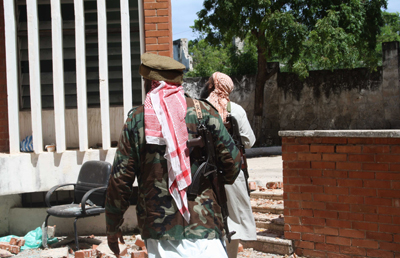On Tuesday, several journalists were wounded when missiles were fired on a press conference in the battlefield of Somalia’s capital, Mogadishu. When the National Union of Somali Journalists broke news of the attack, I immediately checked in with local reporters. I obtained the phone number of photojournalist Ilyas Ahmed Abukar, expecting to speak to a frantic or traumatized man, but to my surprise, Abukar was alert, calm, and willing to share his personal account of what transpired. After a short conversation, he pledged to continue answering my questions via e-mail. Here is some of what he told me.
Abukar describes how it was noon on Tuesday when journalists were gathered at the former National Security Agency premises, which hardline Islamist rebel group Al-Shabaab captured from the government on Monday. He said the group had called the media there to show off their prize.
“Shabaab spokesman Sheikh Ali Mohamud took us to the buildings,” Abukar wrote. “As we were entering the first building, heavy missiles started to fall around us. We all ran inside the buildings to escape the shelling, but before we entered the concrete building, the missiles hit on the top of the door which we wanted to enter and destroyed the door. There are several journalists with small injuries. The two with the heavy injuries are me, Ilyas from Badri Media Productions, and Al-Jazeera cameraman Abdinaser Hared. We have injuries on the heads, necks, and back. But we are not so serious. The other journalists who are injured include Muse Mohamud Jiisow, the editor of Somalisan, Abdirisaq Jama Elmi from Somali TV, Abdinaser Idle from HornAfrik, but I don’t remember the others.”
The next sentence left me in disbelief: “Now my problem is that I can’t move my left hand, because the fragments of the missile are still in my hand and my head.”
Over the phone, Abukar had classified his injuries as minor, but I wonder if that was the effect of the painkillers he described in the next sentence. “Al-Shabaab’s medical team injected us painkillers and provided bandages to us, so instead of going out we continued to the press conference.” According to Abukar, the journalists were indirectly targeted, saying he believes the government wanted to stop the press conference so the media wouldn’t report Al-Shabab’s “propaganda of advancing to the presidential palace.”
“There is blood on the lens of my camera,” Abukar said, referring to his Canon 1000D.
He does not wear a bulletproof vest or helmet. “I know it’s very risky,” he wrote. “I like to work the profession of a journalist–to display risk of war, militants, to display everything to the world.” Abukar said he has been covering the war-torn Somali capital since June 2007: “I was a secondary school student, but I got training from the Somali journalist Abukar Albadri, who was forced to leave Mogadishu. He trained us as a team and gave us cameras and told us to do the work he was doing, it was photojournalism, so we established Badri Media Productions and we work there as a team.” He is also a reporter with Somali news website Qalin (Pen).
“To work with a camera in a war zone is like a curse,” he went on. “In the morning when you are leaving the office for assignment or want to cover an ongoing war, you are compromising your life, because you are not sure if you will return alive.”
There are risks everywhere: “Not only bullets and stray missiles,” he wrote. “You are also a potential target for any gunman and all the warring parties that are hostile to the journalists. But when you return to the office safely with the photos it is like winning the World Cup because you are safe and you have the pictures.”
Many Somali journalists have fled into exile, fearing for their lives, but Abukar said he is determined to continue his work. “If we stop doing the job then who is coming to do it?” he asked. “I must work as a photographer as long as I can live and help the world understand the situation of my people.”
